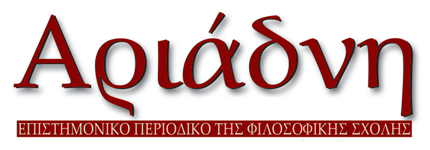Στα Παλάτια της Κνωσού: η μεταμφίεση μιας αμφιθυμίας του Νίκου Καζαντζάκη
DOI:
https://doi.org/10.26248/ariadne.v0i23-24.798Περίληψη
DURING the years of German occupation of Greece, Nikos Kazantzakis had his most creative writing career. Among other texts that the author worked during that period, Kazantzakis completed the last (?) writing of his novel for children At the Palaces of Knossos, a text which is a cross-section. With this mythological novel, Kazantzakis redefines his relationship with Hellenism and its history. The Minoan Crete is a “mirror image” of British Empire of his time, whereby the narrator exploits the multiperspectivity of the ancient myth and makes a dialogue with travelogues, Odyssey, but mainly with colonial reception of the Minoan archaeology. The comparative approach of the subject, in conjunction with the study of the manuscript At the Palaces of Knossos demonstrates that this text is the prelude of the author’s reconciliation with Hellenism which was validated by his last work Report to Greco (Anafora ston Greco).
Λήψεις
Δημοσίευση
Πώς να δημιουργήσετε Αναφορές
Τεύχος
Ενότητα
Άδεια
Οι εργασίες που δημοσιεύονται στο περιοδικό μπορούν να χρησιμοποιηθούν ελεύθερα για μη-εμπορικούς σκοπούς με την προϋπόθεση ότι γίνεται αναφορά στους συγγραφείς και την πρώτη δημοσίευση. Στην περίπτωση που το άρθρο αλλοιωθεί, τροποποιηθεί ή δημιουργηθεί κάτι νέο βασισμένο στο αρχικό, το έργο που θα προκύψει θα μπορεί να διανεμηθεί μόνο με την ίδια ή παρόμοια άδεια (Creative Commons Attribution-NonCommercial-ShareAlike 4.0 International License).


